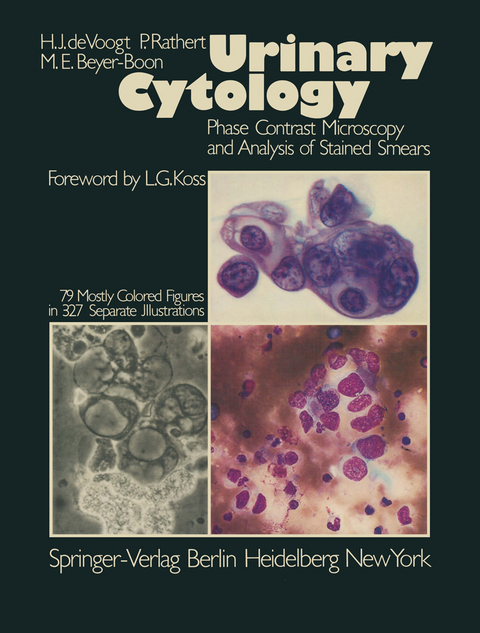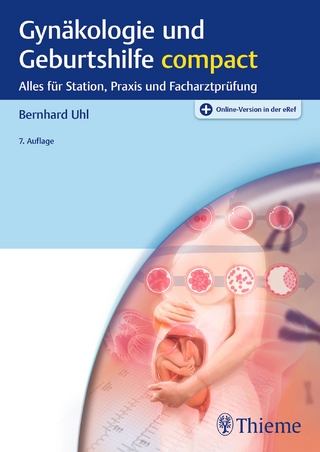
Urinary Cytology
Springer Berlin (Verlag)
978-3-642-96390-2 (ISBN)
1. Clinical Application of Urinary Cytology.- 2. Preparatory Techniques.- 2.1. Collection of Material.- 2.1.1. Urine.- 2.1.2. Bladder and Renal Plevis Washings.- 2.1.3. Brushing Techniques.- 2.1.4. Prefixation.- 2.2. Cell Concentration Techniques.- 2.3. Smear Preparation Techniques.- 2.3.1. Smears for Phase Contrast Microscopy and Methylene Blue Staining (Non-Permanent)..- 2.3.2. Smears for the Papanicolaou Stain (Permanent).- 2.3.2.1. Smears form Freshly Voided Urine.- 2.3.2.2. Smears from Prefixed Urine.- 2.3.2.3. Smears for the MGG Method (Permanent)..- 2.4. Staining Methods.- 2.4.1. Methylene Blue Stain.- 2.4.2. Papanicolaou Stain.- 2.4.3. May-Gruenwald Giesma Staining Method..- 2.5. Pitfalls.- 2.5.1. Cell Degeneration.- 2.5.2. Formalin Effect.- 2.5.3. The Damaging Effect of Hypertonic Urine.- 2.5.4. Cell Loss During Staining.- 2.5.5. Overstaining.- 2.5.6. Cellular and Nuclear Shrinkage.- 3. Urinary Cytology and its Relationship to Histology of the Urinary Tract.- 3.1. Normal Structure of Urothelium.- 3.1.1. Histology of Normal Urothelium.- 3.1.2. Epithelial Variants.- 3.1.3. Cytology of Normal Urothelium.- 3.2. Epithelial Contamination.- 3.3. Benign Urothelial Lesions.- 3.3.1. Inflammatory Changes.- 3.3.1.1. Bacterial Infections.- 3.3.1.2. Viral Infections.- 3.3.1.3. Parasitic Infections.- 3.3.1.4. Mycotic Infections.- 3.3.2. Malakoplakia.- 3.3.3. Squamous Metaplasia.- 3.3.4. Glandular Cystitis.- 3.3.5. Urinary Calculi.- 3.3.6. Hyperplasia of the Urothelium.- 3.3.7. Atypical Hyperplasia of the Urothelium.- 3.3.8. Condylomata Acuminata.- 3.4. Urothelial Tumors.- 3.4.1. Introduction.- 3.4.2. Classification of Urothelial Tumors.- 3.4.2.1. Macroscopy.- 3.4.2.2. Microscopy.- 3.4.2.3. Stage.- 3.4.2.4. Clinical Classification (UICC).- 3.4.3. Macroscopy and Histology of Pure Transitional Cell Tumors.- 3.4.3.1. Papillary Tumors.- 3.4.3.2. Solid Tumors.- 3.4.3.3. Flat Intra-Epithelial Carcinomas (Carcinoma in situ).- 3.4.4. Cytology of Pure Urothelial Tumors.- 3.4.4.1. Papillary Tumors Grade 0 (Benign Papilloma) and Grade 1 (Papilloma with Atypia).- 3.4.4.2. Papillary Tumors, Grade 2, 3 and 4 (Carcinomas).- 3.4.4.3. Solid Urothelial Carcinomas.- 3.4.4.4. Carcinoma in situ.- 3.4.5. Squamous Differentiation of Transitional Cell Carcinoma and Pure Squamous Cell Carcinoma.- 3.4.6. Adenomatous Differentiation of Transitional Cell Carcinoma and Pure Adenocarcinoma..- 3.5. Adenocarcinoma of the Prostate.- 3.6. Infiltration of the Bladder or Ureter from Adjacent Carcinomas and Metastasis of other Carcinoma.- 3.7 Adenocarcinoma of the Kidney.- 3.8. Effect of Radiation on the Urothelium.- 3.9. Effect of Cancer Drugs.- 4. Phase Contrast Microscopy of the Urinary Sediment.- 5. Methylene Blue Stain of the Urinary Sediment.- 6. Epidemiology and Etiology of Urothelial Tumors.- 7. Efficacy of Urinary Cytology in the Detection of Tumors of the Urinary Tract.- 7.1. Diagnosis of Patients with positive Cytological Results.- 7.2. Diagnosis of Patients with Atypical Findings.- 7.3. Sensitivity and Specificity of Urinary Cytology.- 7.4. The Validity of the Provisional Contrast Microscopy Diagnosis.- 7.4.1. Phase Contrast Microscopy Underdiagnosis..- 7.4.2. Phase Contrast Microscopy Overdiagnosis..- Acknowledgement.- References.- Illustrations.- 1. Normal Transitional Epithelium.- 2. Inflammatory Changes.- 3. Non-Bacterial Inflammations and Contaminants.- 4. Atypical Hyperplasia.- 5. Phase Contrast Microscopy: Criteria for Malignancy.- 6. Grade 1 Tumors of the Bladder.- 7. Grade 2 Tumors of the Bladder, with and without Infiltrative Growth.- 8. Grade 2 Bladder Tumors and Grade 3 Uroteral Tumor.- 9. Grade 2 Tumors of Bladder and Urethra with Infiltrative Growth.- 10. Grade 3 Tumors of Bladder, Renal Pelvis and Ureter.- 11. Grade 3 Tumors of Renal Pelvis, Ureter and Bladder.- 12. Grade 4 Bladder Tumors.- 13. Grade 4 Solid Carcinoma of the Bladder.- 14. Carcinoma in situ.- 15. Squamous Cell Carcinoma of the Bladder.- 16. Adenomatous Differentiation.- 17. Adenocarcinoma.- 18. Adenocarcinoma of Kidney.- 19. Bladder Cancer and Prostate Cancer.- 20. Cystitis Glandularis Combined with Squamous Metaplasia.- 21. Effects of Radiation.- 22. Effects of Cytostatic Drugs on Urothelial Cells.- 23. Cytological Changes Due to Urinary Calculi.- 24. Catheter Urine.- 25. Ileal Stomal Urine.- 26. Artifacts in PCM.
| Erscheint lt. Verlag | 16.3.2012 |
|---|---|
| Einführung | L.G. Koss |
| Zusatzinfo | X, 196 p. |
| Verlagsort | Berlin |
| Sprache | englisch |
| Maße | 210 x 279 mm |
| Gewicht | 519 g |
| Themenwelt | Medizin / Pharmazie ► Medizinische Fachgebiete ► Gynäkologie / Geburtshilfe |
| Medizin / Pharmazie ► Medizinische Fachgebiete ► Urologie | |
| Naturwissenschaften ► Biologie ► Zellbiologie | |
| Schlagworte | Blasenkrebs • Cytologic Grading • Cytopathology • Diagnosis • Erythrocyte Morphology • Harnweg • Harnwegsgeschwulst • Immunocytology • Influence • Urinary Cytology • Urothelial Tumors • Zytodiagnostik • Zytologie • Zytometrie |
| ISBN-10 | 3-642-96390-0 / 3642963900 |
| ISBN-13 | 978-3-642-96390-2 / 9783642963902 |
| Zustand | Neuware |
| Haben Sie eine Frage zum Produkt? |
aus dem Bereich


